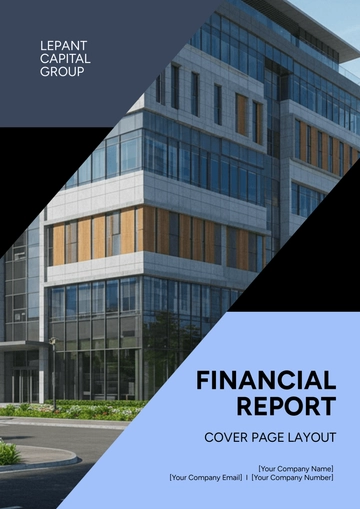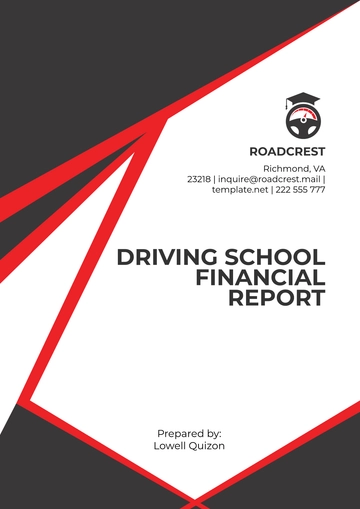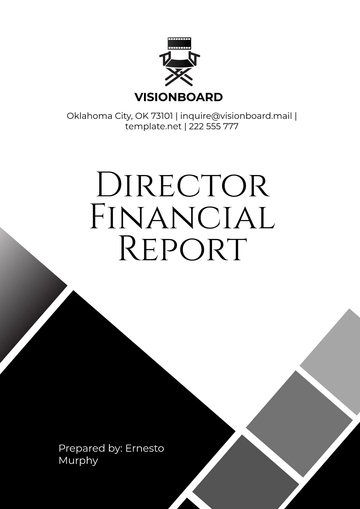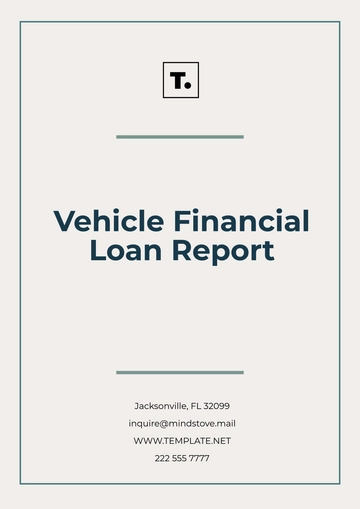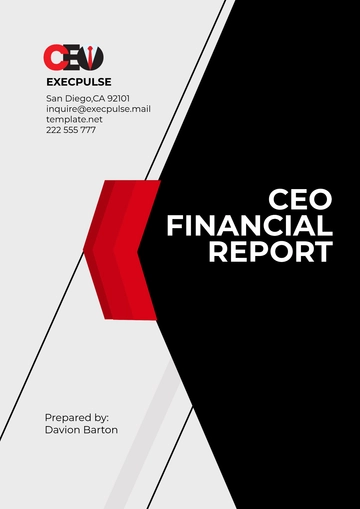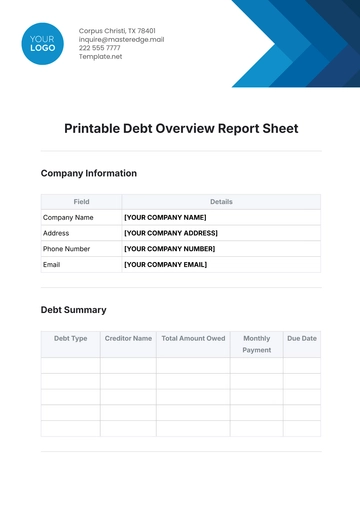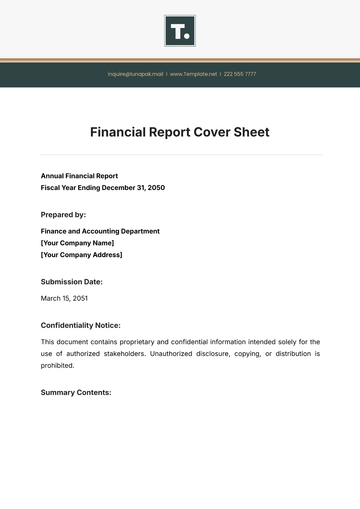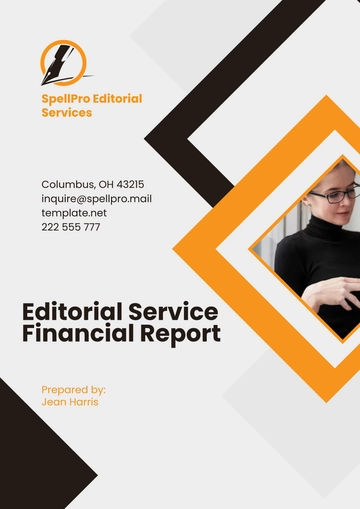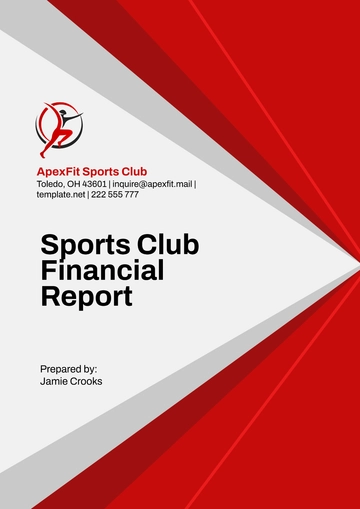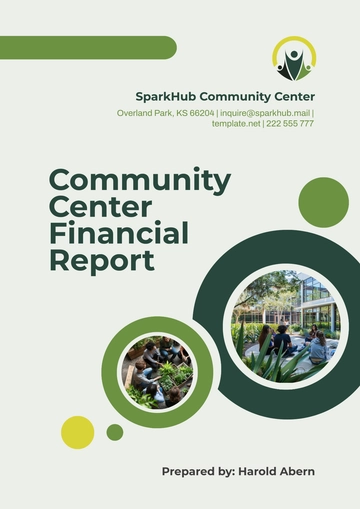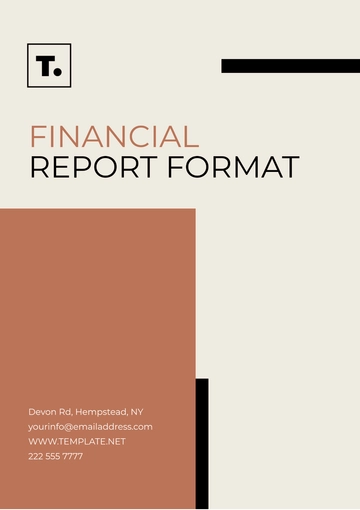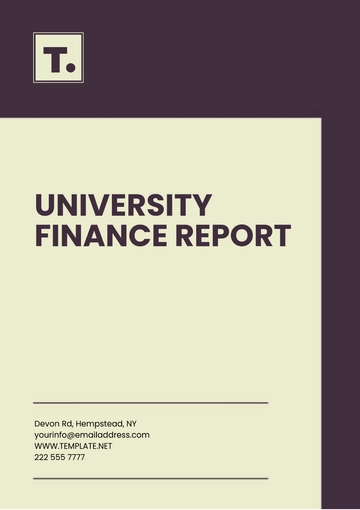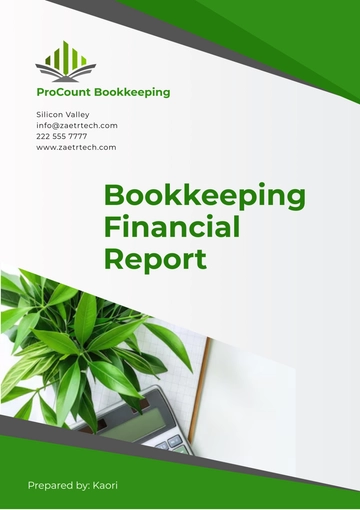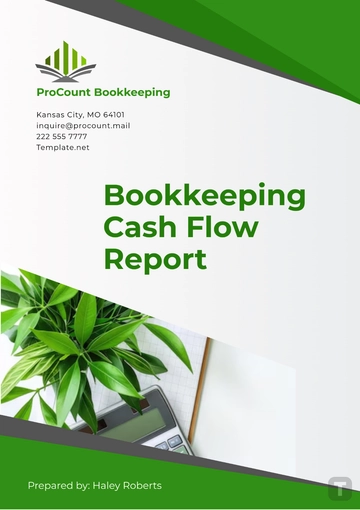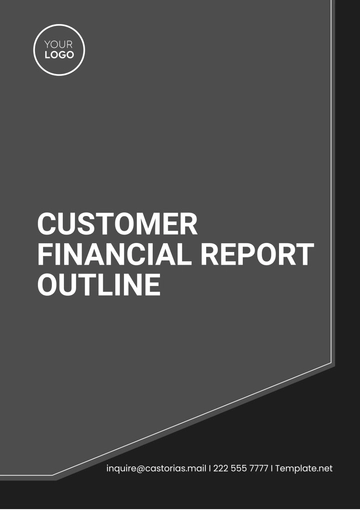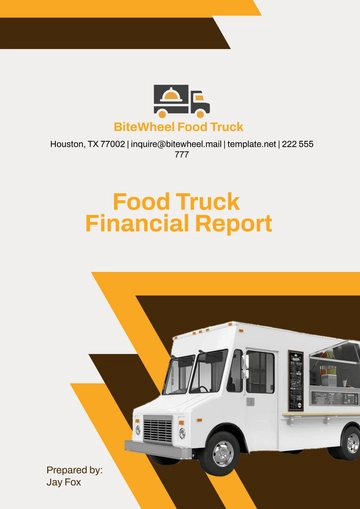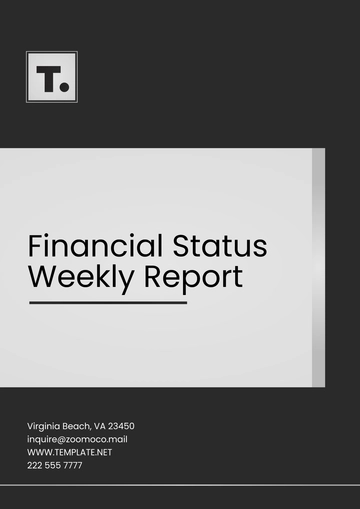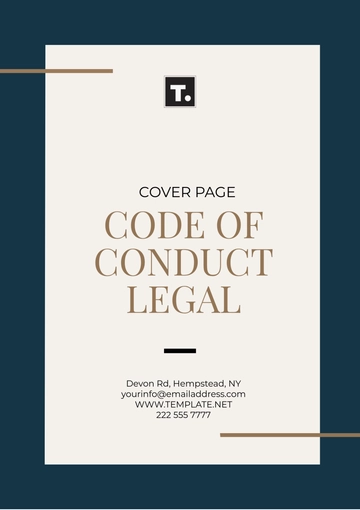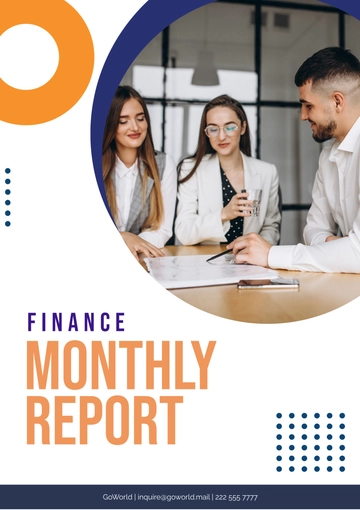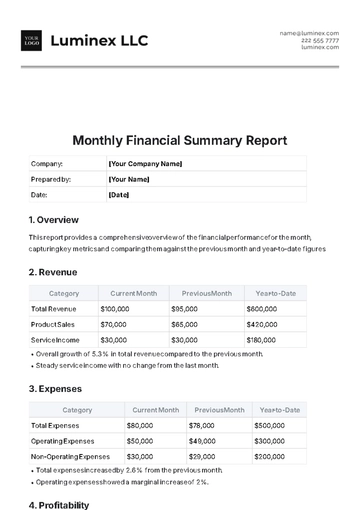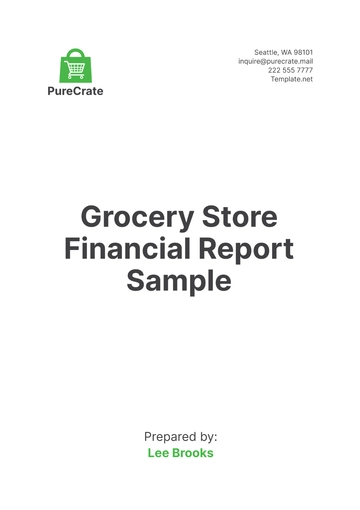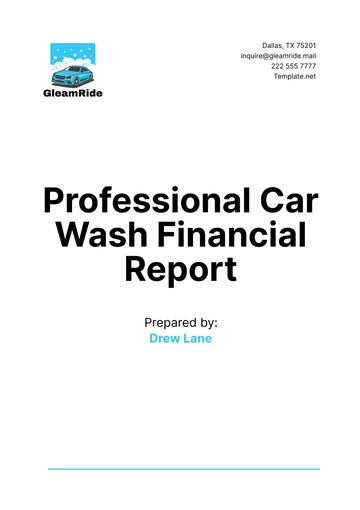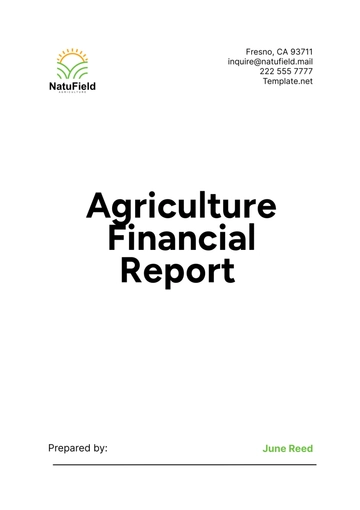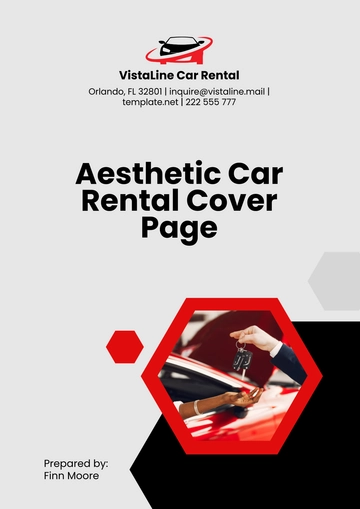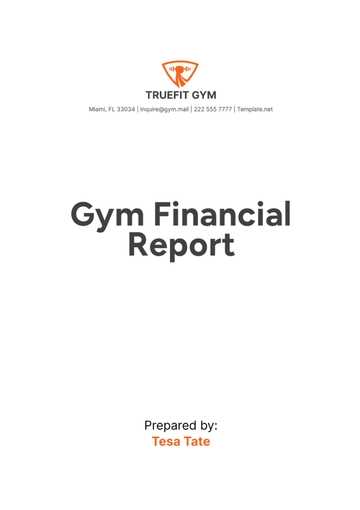Free Cafe Financial Report
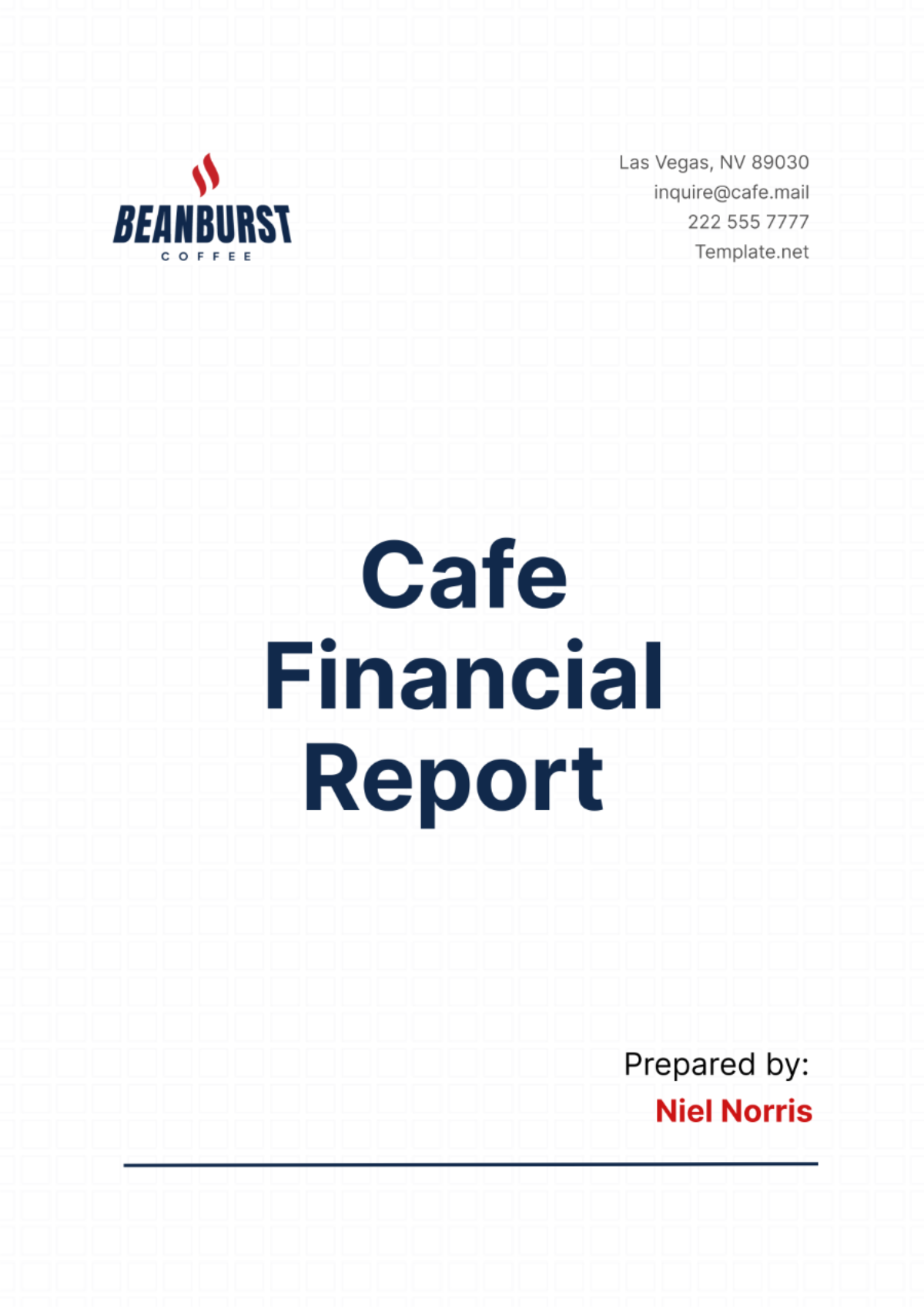
I. Executive Summary
The financial report for [Your Company Name] covers the fiscal year from [Start Date] to [End Date]. This report provides a comprehensive analysis of our financial performance, including revenue and expense breakdowns, profitability analysis, liquidity, and solvency metrics. Over the past year, [Your Company Name] has experienced significant growth in revenue, driven by an increase in customer footfall and successful marketing campaigns. However, rising costs in raw materials and labor have impacted our profit margins. This report aims to highlight the key financial metrics and provide insights into our operational efficiency and financial health.
Key financial highlights include:
Total revenue increased by 15% compared to the previous year.
The gross profit margin stood at 65%, indicating efficient cost management.
Net profit margin was 12%, reflecting the impact of increased operating expenses.
Liquidity ratios suggest strong short-term financial stability.
The report concludes with strategic recommendations to enhance profitability and sustain growth, focusing on cost control measures and revenue diversification.
II. Introduction
The purpose of this financial report is to present a detailed analysis of [Your Company Name]'s financial performance for the fiscal year [Year]. This report covers key financial statements, including the income statement, balance sheet, and cash flow statement, providing a holistic view of the cafe's financial health. The financial data presented in this report have been compiled from our accounting records, verified by internal audits, and benchmarked against industry standards.
This report aims to inform stakeholders, including management, investors, and creditors, about the financial status of [Your Company Name] and to support decision-making processes for future growth and sustainability. The scope of this report includes an in-depth analysis of revenue and expenses, profitability, liquidity, and solvency metrics. Additionally, the report outlines key financial risks and provides strategic recommendations for financial improvement.
III. Financial Statements
A. Income Statement
The income statement provides a detailed account of [Your Company Name]'s revenue and expenses over the fiscal year, culminating in the net profit or loss for the period.
Income Statement | [Fiscal Year] |
|---|---|
Revenue | $1,200,000 |
Cost of Goods Sold | $420,000 |
Gross Profit | $780,000 |
Operating Expenses | $600,000 |
Operating Profit | $180,000 |
Other Expenses | $36,000 |
Net Profit | $144,000 |
B. Balance Sheet
The balance sheet provides a snapshot of the cafe's financial position, detailing assets, liabilities, and owner's equity as of the end of the fiscal year.
Balance Sheet | [Fiscal Year End] |
|---|---|
Assets | |
Current Assets | $250,000 |
Fixed Assets | $500,000 |
Other Assets | $50,000 |
Total Assets | $800,000 |
Liabilities | |
Current Liabilities | $150,000 |
Long-term Liabilities | $200,000 |
Total Liabilities | $350,000 |
Owner’s Equity | $450,000 |
C. Cash Flow Statement
The cash flow statement outlines the inflows and outflows of cash, categorized into operating, investing, and financing activities, providing a clear picture of cash management over the fiscal year.
Cash Flow Statement | [Fiscal Year] |
|---|---|
Operating Activities | $200,000 |
Investing Activities | -$100,000 |
Financing Activities | $50,000 |
Net Cash Flow | $150,000 |
IV. Revenue Analysis
The revenue analysis delves into the different sources of income for [Your Company Name], examining trends, growth rates, and factors influencing revenue generation.
A. Revenue Breakdown
[Your Company Name] generates revenue primarily from three sources: dine-in sales, takeout orders, and catering services. The following table provides a detailed breakdown of revenue for the fiscal year:
Revenue Source | Amount | Percentage of Total Revenue |
|---|---|---|
Dine-in Sales | $720,000 | 60% |
Takeout Orders | $360,000 | 30% |
Catering Services | $120,000 | 10% |
Total Revenue | $1,200,000 | 100% |
B. Revenue Trends and Growth Rates
Over the past year, [Your Company Name] has witnessed a 15% increase in total revenue. This growth can be attributed to several factors:
Enhanced marketing efforts, including social media campaigns and local partnerships, which boosted customer footfall.
Introduction of new menu items and seasonal promotions, attracting repeat customers and increasing average ticket size.
Expansion of catering services, catering to corporate clients and private events.
C. Comparison to Previous Periods
When compared to the previous fiscal year, the revenue from dine-in sales increased by 10%, takeout orders by 20%, and catering services by 30%. The introduction of a loyalty program has also contributed to higher customer retention and increased frequency of visits.
D. Seasonal Variations and Factors Affecting Revenue
Revenue for [Your Company Name] exhibits seasonal variations, with peak sales occurring during the holiday season and summer months. Factors influencing revenue include:
Seasonal menu offerings and promotions.
Increased foot traffic during local events and festivals.
Marketing campaigns timed to coincide with peak periods.
V. Expense Analysis
The expense analysis provides a detailed examination of the operating costs incurred by [Your Company Name], highlighting areas of expenditure and identifying opportunities for cost control.
A. Breakdown of Operating Expenses
Operating expenses for [Your Company Name] are categorized into several major components. The table below outlines the breakdown of these expenses for the fiscal year:
Expense Category | Amount | Percentage of Total Expenses |
|---|---|---|
Food and Beverage Costs | $300,000 | 50% |
Labor Costs | $180,000 | 30% |
Rent and Utilities | $60,000 | 10% |
Marketing and Advertising | $30,000 | 5% |
Maintenance and Repairs | $18,000 | 3% |
Other Operating Expenses | $12,000 | 2% |
Total Operating Expenses | $600,000 | 100% |
B. Cost Control Measures and Efficiency Improvements
To manage and control operating expenses, [Your Company Name] has implemented several measures:
Food and Beverage Costs: Negotiated better terms with suppliers and focused on reducing food waste through improved inventory management.
Labor Costs: Optimized staff scheduling to align with peak hours, reducing overtime expenses and enhancing productivity.
Rent and Utilities: Invested in energy-efficient appliances and lighting to lower utility bills.
Marketing and Advertising: Utilized cost-effective digital marketing strategies, leveraging social media and email marketing campaigns.
Maintenance and Repairs: Adopted a preventive maintenance schedule to minimize unexpected repair costs and equipment downtime.
C. Comparison to Budgeted Expenses and Previous Periods
Operating expenses for the fiscal year were closely aligned with budgeted projections. Food and beverage costs slightly exceeded budgeted amounts due to an increase in raw material prices. Labor costs were managed effectively, staying within the budget through optimized scheduling and workforce management. Compared to the previous fiscal year, total operating expenses increased by 8%, primarily due to higher marketing expenditures aimed at driving revenue growth.
VI. Profitability Analysis
The profitability analysis evaluates the financial performance of [Your Company Name], focusing on key profit margins and profitability drivers. The gross profit margin measures the proportion of revenue that exceeds the cost of goods sold (COGS). For the fiscal year, [Your Company Name] achieved a gross profit margin of 65%. The operating profit margin indicates the percentage of revenue remaining after accounting for operating expenses. For the fiscal year, the operating profit margin was 15%. The net profit margin reflects the percentage of revenue remaining after all expenses have been deducted. For the fiscal year, [Your Company Name] reported a net profit margin of 12%.
A. Analysis of Profitability Drivers
Several factors have contributed to the profitability of [Your Company Name]:
Revenue Growth: Increased customer footfall and higher average ticket size have driven revenue growth, contributing to higher profitability.
Cost Management: Effective cost control measures, particularly in food and labor costs, have helped maintain healthy profit margins.
Operational Efficiency: Streamlined operations and optimized staff scheduling have reduced operating expenses and enhanced overall profitability.
B. Comparison to Industry Benchmarks
The profitability metrics of [Your Company Name] compare favorably to industry benchmarks. The gross profit margin of 65% exceeds the industry average of 60%, indicating efficient cost management. The operating profit margin of 15% and net profit margin of 12% are also above industry averages of 10% and 8%, respectively, reflecting strong financial performance and operational efficiency.
VII. Liquidity and Solvency Analysis
The liquidity and solvency analysis assesses [Your Company Name]'s ability to meet its short-term and long-term financial obligations. This analysis is crucial for understanding the financial stability and sustainability of the cafe.
A. Liquidity Ratios
Liquidity ratios measure the ability of [Your Company Name] to cover its short-term liabilities with its short-term assets. The two primary liquidity ratios are the current ratio and the quick ratio.
Current Ratio: The current ratio is calculated by dividing current assets by current liabilities. A current ratio of 1.67 indicates that [Your Company Name] has $1.67 in current assets for every $1.00 of current liabilities, suggesting good short-term financial health.
Quick Ratio: The quick ratio, also known as the acid-test ratio, excludes inventory from current assets and provides a more stringent measure of liquidity. A quick ratio of 1.33 indicates that [Your Company Name] has $1.33 in liquid assets for every $1.00 of current liabilities, demonstrating the cafe's ability to meet its short-term obligations without relying on inventory sales.
B. Solvency Ratios
Solvency ratios assess the long-term financial stability of [Your Company Name] by examining its ability to meet long-term obligations. The primary solvency ratio is the debt-to-equity ratio.
Debt-to-Equity Ratio: The debt-to-equity ratio is calculated by dividing total liabilities by owner's equity. A debt-to-equity ratio of 0.78 indicates that [Your Company Name] has $0.78 in debt for every $1.00 of equity, reflecting a conservative approach to leverage and a strong equity position.
C. Analysis of Financial Stability
The liquidity and solvency ratios suggest that [Your Company Name] is financially stable with a strong ability to meet both short-term and long-term obligations. The healthy current and quick ratios indicate good liquidity, while the low debt-to-equity ratio highlights a manageable level of debt and a solid financial foundation.
VIII. Capital Expenditures and Investments
This section provides an overview of [Your Company Name]'s major capital expenditures and investments during the fiscal year, along with an analysis of their impact on the cafe's financial performance and future growth prospects.
A. Summary of Major Capital Expenditures
During the fiscal year, [Your Company Name] made significant capital investments in the following areas:
Renovation and Expansion: $100,000 was invested in renovating the existing cafe space and expanding seating capacity to accommodate more customers.
New Equipment: $50,000 was spent on purchasing new kitchen equipment and upgrading existing appliances to improve operational efficiency.
Technology Upgrades: $20,000 was invested in upgrading the cafe's point-of-sale system and implementing a customer loyalty program.
B. Return on Investments (ROI) Analysis
The ROI analysis evaluates the financial benefits generated from these capital expenditures. The renovation and expansion have led to a 20% increase in customer footfall, contributing significantly to the overall revenue growth. The new equipment has improved kitchen efficiency, reducing food preparation time and enhancing customer satisfaction. Technology upgrades have streamlined operations and boosted repeat business through the loyalty program.
Capital Expenditure | Amount | Estimated ROI |
|---|---|---|
Renovation and Expansion | $100,000 | 25% |
New Equipment | $50,000 | 20% |
Technology Upgrades | $20,000 | 15% |
C. Future Investment Plans and Capital Needs
Looking ahead, [Your Company Name] plans to invest in the following areas to sustain growth and enhance customer experience:
Opening a New Branch: $150,000 will be allocated to opening a new branch in a high-traffic location to increase market reach.
Digital Marketing Campaigns: $30,000 will be invested in digital marketing to attract new customers and strengthen brand presence.
Sustainable Practices: $20,000 will be dedicated to implementing sustainable practices, such as energy-efficient appliances and eco-friendly packaging, to appeal to environmentally conscious customers.
These investments are expected to drive future revenue growth, improve operational efficiency, and align with the cafe's long-term strategic goals.
IX. Financial Ratios and Metrics
This provides an analysis of key financial ratios and metrics for [Your Company Name], comparing them to industry standards and interpreting their implications for the cafe's financial health and performance.
A. Key Financial Ratios
The following table summarizes key financial ratios for [Your Company Name] for the fiscal year:
Financial Ratio | [Your Company Name] | Industry Standard |
|---|---|---|
Gross Profit Margin | 65% | 60% |
Operating Profit Margin | 15% | 10% |
Net Profit Margin | 12% | 8% |
Return on Assets (ROA) | 18% | 15% |
Return on Equity (ROE) | 32% | 25% |
B. Performance Metrics Compared to Industry Standards
The financial ratios indicate that [Your Company Name] is performing well above industry standards. The gross profit margin of 65% suggests efficient cost management and a strong ability to generate profit from sales. The operating profit margin of 15% and net profit margin of 12% reflect effective control of operating expenses and overall profitability.
The return on assets (ROA) of 18% and return on equity (ROE) of 32% highlight the efficient use of assets and equity to generate profits, demonstrating strong financial performance and management effectiveness.
C. Interpretation and Implications of the Ratios
The high gross profit margin indicates that [Your Company Name] is managing its cost of goods sold effectively, leaving a substantial portion of revenue to cover operating expenses and generate profit. The operating profit margin and net profit margin further confirm that the cafe is controlling its operating expenses efficiently, resulting in healthy profitability.
The ROA and ROE ratios suggest that the cafe is using its assets and equity productively to generate returns, reflecting strong management performance and financial health. These positive financial metrics imply that [Your Company Name] is well-positioned for future growth and sustainability, with a robust foundation to support ongoing operations and strategic initiatives.
X. Risk Analysis and Management
This identifies the key financial risks facing [Your Company Name] and outlines the strategies implemented to mitigate these risks, ensuring the cafe's long-term financial stability and resilience.
A. Identification of Financial Risks
[Your Company Name] faces several financial risks that could impact its operations and profitability. The primary risks include:
Market Risk: Fluctuations in customer demand and changing consumer preferences could affect revenue.
Credit Risk: The potential for customers or clients to default on payments, impacting cash flow.
Operational Risk: Risks associated with daily operations, including equipment failure, supply chain disruptions, and workforce issues.
Regulatory Risk: Changes in regulations and compliance requirements could lead to increased costs and operational challenges.
B. Risk Mitigation Strategies
To address these risks, [Your Company Name] has implemented the following risk mitigation strategies:
Market Risk Mitigation: Diversified revenue streams through catering services and takeout options to reduce dependency on dine-in sales. Regularly updating the menu to align with customer preferences and trends.
Credit Risk Mitigation: Conducting credit checks for large clients and implementing strict payment terms. Offering incentives for early payments and monitoring accounts receivable closely.
Operational Risk Mitigation: Establishing preventive maintenance schedules for equipment to minimize downtime. Developing contingency plans for supply chain disruptions and maintaining strong relationships with multiple suppliers.
Regulatory Risk Mitigation: Staying informed about regulatory changes and ensuring compliance through regular audits. Engaging with industry associations to advocate for favorable policies.
C. Impact of External Factors
External factors, such as economic conditions, technological advancements, and competitive landscape, also pose risks to [Your Company Name]. To mitigate these risks, the cafe has adopted a proactive approach by continuously monitoring market trends, investing in technology to enhance operational efficiency, and differentiating its offerings to maintain a competitive edge.
XI. Recommendations and Action Plan
Based on the financial analysis and risk assessment, this section provides strategic recommendations and an action plan to enhance [Your Company Name]'s financial performance and ensure sustainable growth.
A. Strategic Recommendations
Cost Optimization: Continue to focus on cost control measures, particularly in food and labor costs, to maintain healthy profit margins. Explore opportunities for bulk purchasing and negotiate better terms with suppliers.
Revenue Diversification: Expand revenue streams by introducing new products and services, such as a subscription-based meal plan or corporate catering packages. Explore partnerships with local businesses to increase customer reach.
Marketing and Branding: Invest in targeted marketing campaigns to attract new customers and retain existing ones. Leverage social media and digital platforms to enhance brand visibility and engagement.
Sustainability Initiatives: Implement sustainable practices to reduce environmental impact and appeal to eco-conscious customers. Consider sourcing ingredients from local and organic suppliers.
B. Action Plan
To implement the strategic recommendations, [Your Company Name] will undertake the following actions:
Cost Optimization Plan:
Conduct a detailed cost analysis to identify areas for potential savings.
Implement a supplier evaluation program to ensure competitive pricing and quality.
Train staff on cost-effective practices and monitor adherence to protocols.
Revenue Diversification Plan:
Develop and launch new products and services aligned with customer needs and preferences.
Form strategic partnerships with local businesses and community organizations.
Introduce loyalty programs and special promotions to drive repeat business.
Marketing and Branding Plan:
Create a comprehensive marketing strategy, including social media, email marketing, and in-store promotions.
Enhance the cafe's online presence through search engine optimization (SEO) and content marketing.
Host events and community activities to increase brand awareness and customer loyalty.
Sustainability Plan:
Conduct an environmental audit to identify areas for improvement.
Invest in energy-efficient equipment and eco-friendly packaging solutions.
Educate staff and customers about sustainability initiatives and encourage participation.
C. Monitoring and Evaluation
To ensure the effectiveness of the recommendations and action plan, [Your Company Name] will implement a robust monitoring and evaluation framework. Key performance indicators (KPIs) will be established to track progress, and regular reviews will be conducted to assess the impact of the initiatives. Adjustments will be made as necessary to align with evolving business needs and market conditions.
- 100% Customizable, free editor
- Access 1 Million+ Templates, photo’s & graphics
- Download or share as a template
- Click and replace photos, graphics, text, backgrounds
- Resize, crop, AI write & more
- Access advanced editor
Track finances accurately with Template.net's Cafe Financial Report Template. This customizable and editable template, accessible via the Ai Editor Tool, helps you draft comprehensive financial reports. Personalize it to include specific financial data and analysis. Ensure clear and professional financial reporting for informed decision-making in your cafe.
You may also like
- Sales Report
- Daily Report
- Project Report
- Business Report
- Weekly Report
- Incident Report
- Annual Report
- Report Layout
- Report Design
- Progress Report
- Marketing Report
- Company Report
- Monthly Report
- Audit Report
- Status Report
- School Report
- Reports Hr
- Management Report
- Project Status Report
- Handover Report
- Health And Safety Report
- Restaurant Report
- Construction Report
- Research Report
- Evaluation Report
- Investigation Report
- Employee Report
- Advertising Report
- Weekly Status Report
- Project Management Report
- Finance Report
- Service Report
- Technical Report
- Meeting Report
- Quarterly Report
- Inspection Report
- Medical Report
- Test Report
- Summary Report
- Inventory Report
- Valuation Report
- Operations Report
- Payroll Report
- Training Report
- Job Report
- Case Report
- Performance Report
- Board Report
- Internal Audit Report
- Student Report
- Monthly Management Report
- Small Business Report
- Accident Report
- Call Center Report
- Activity Report
- IT and Software Report
- Internship Report
- Visit Report
- Product Report
- Book Report
- Property Report
- Recruitment Report
- University Report
- Event Report
- SEO Report
- Conference Report
- Narrative Report
- Nursing Home Report
- Preschool Report
- Call Report
- Customer Report
- Employee Incident Report
- Accomplishment Report
- Social Media Report
- Work From Home Report
- Security Report
- Damage Report
- Quality Report
- Internal Report
- Nurse Report
- Real Estate Report
- Hotel Report
- Equipment Report
- Credit Report
- Field Report
- Non Profit Report
- Maintenance Report
- News Report
- Survey Report
- Executive Report
- Law Firm Report
- Advertising Agency Report
- Interior Design Report
- Travel Agency Report
- Stock Report
- Salon Report
- Bug Report
- Workplace Report
- Action Report
- Investor Report
- Cleaning Services Report
- Consulting Report
- Freelancer Report
- Site Visit Report
- Trip Report
- Classroom Observation Report
- Vehicle Report
- Final Report
- Software Report
